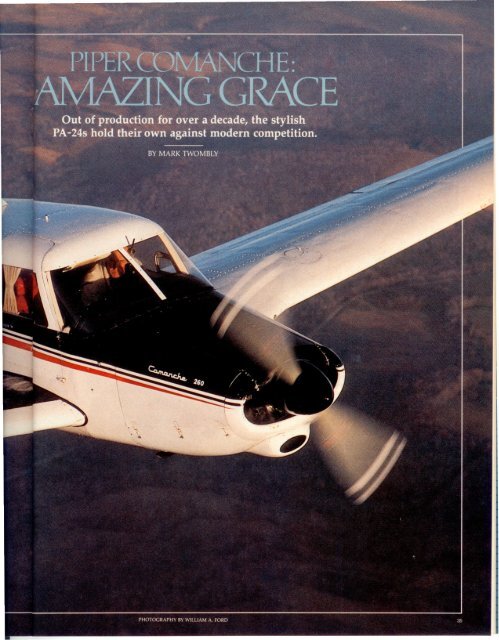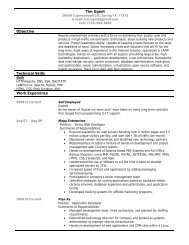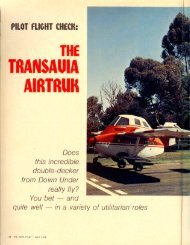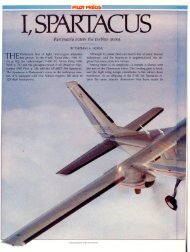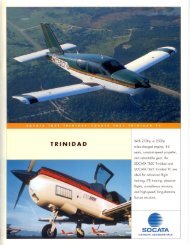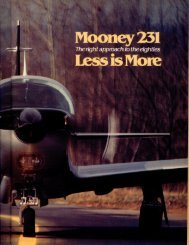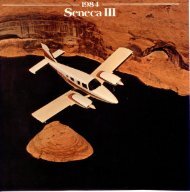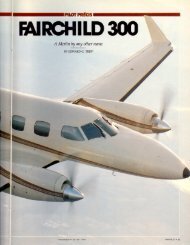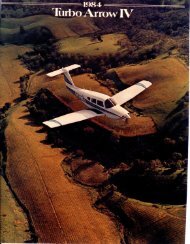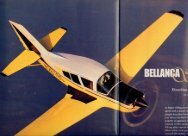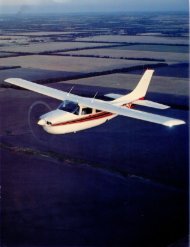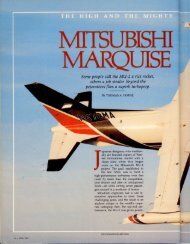comanche spoiter's guide - Aero Resources Inc
comanche spoiter's guide - Aero Resources Inc
comanche spoiter's guide - Aero Resources Inc
- No tags were found...
You also want an ePaper? Increase the reach of your titles
YUMPU automatically turns print PDFs into web optimized ePapers that Google loves.
continuedthat any single-engine airplane that could leave passengerssmiling after an"all-day flight was worthy of praise.That trip also left me with pleasant thoughts about theComanche's flying characteristics. The flight controls arebeautifully balanced. Pilots who are apprehensive aboutwrestling with a high-performance single will be bowledover by the smooth, easy handling of the Comanche.My euphoria ended on the landing flare. The Comancheis a floater, and it also is easy to touch down nosewheelfirst. The flaps extend to 32 degrees on 1962 and later Comanches,and the main gear struts are short, so a springycushion of ground effect piles up underneath the airplane toforestall the touchdown. Comanche pilots have developedseveral techniques for minimizing float and a wheelbarrowlanding. One is to retract the electric flaps during the flare.However, this procedure rates a thumbs down from manyinstructors. Aircraft accident statistics are replete with incidentsof pilots reaching for the flap switch but activating thegear-up switch instead.Some Comanche pilots complain that retracting the flapson the flare leads to an "arrival" or firm landing rather thana smooth touchdown. Their solution to the float is to pumpup the main gear struts to increase ground clearance. On theramp, a Comanche sits in a tail-low attitude, which meansthat, on landing, the pilot has to get the nose up very highto ensure that the main wheels touch first.There are other quirks. The takeoff roll can seem interminable.The Comanche requires a lot of speed before thelong, narrow wing generates enough lift for rotation andclimb-out. Also, early model Comanches have flight instrumentsarranged in a non-standard pattern. Engine instrumentsand fuel gauges are located on the right side of thepanel, where they are difficult to monitor. Unless the panelhas been updated, gyro instruments very well may be militarysurplus relics.Piper built seven versions of the PA-24, beginning withthe 180 in 1958. The horsepower increased in steps, from180 to 250 in 1958, to 260 in 1964, to a flirtation with 400hp in 1964 and 1965 and, finally, to a twin-turbocharged260-hp Comanche in models from 1970 through 1972.Although 180 hp does not seem to be quite enough for afour-place airplane with a gross weight of 2,500 pounds, thePA-24-180 proved to be quite popular. There were 1,143built between 1958 and 1964. The trade-off for a lowerclimb rate, slower cruise speeds and less payload in the 180,compared to the 250 and 260 Comanches, is lower operatingcost. The four-cylinder Lycoming 0-360 is more fuelefficientthan the 250- and 260-hp six-cylinder Lycoming 0540s and 10-540s, and the overhaul is less expensive.The Comanche 180 maintains respectable cruise speeds,thanks to the efficient wing and a constant speed propeller.At 55 percent power, the 180 should cruise at 116 knotswhile using only 7.5 gph. At 75 percent power, speed increasesto 139 knots, with a fuel flow of 10 to 11 gph.The Comanche's performance increased dramatically withthe introduction of the 250. Cruise speeds at all powersettings jumped 20 knots, and the climb rate increased morethan 50 percent, to 1,400 fpm. Although the 250 is heavierthan the 180, useful load increased 125 pounds. Piper beganoffering two IS-gallon outboard wing tanks as an option onboth the 180 a,nd 250 Comanches in 1961. With full tanks90 gallons-the 250 could cover more than 1,000 nm.In 1964, fuel injection, another 10 hp and 100 pounds38. FEBRUARY 1985
Older Comallches such as this 1965260 oftell presellt amix of modem aviollics alld archaic placemellt of flight illstrumellts.The red-leather "Palm Beach" illferior was a luxury Opti01I.were added to the Comanche. The 180 and 250 weredropped. Takeoff distance decreased, and the climb rate increased.The 260 was a few knots faster than the 250, buteach knot cost an extra gallon-per-hour of fuel.The basic PA-24 airframe changed little until the 260 Bwas introduced in 1966. The 260 B fuselage was about sixinches longer than previous Comanches, which allowedPiper to add a third set of windows along the side and offerfifth and sixth passenger seats as an option. Gross weightincreased 200 pounds, to 3,100 pounds, and the 1,012pound payload with standard 60-gallon fuel capacity enabledall six seats to be occupied, and a suitcase or twocould be stowed in the baggage compartment.The Comanche reached its aesthetic peak with the 260 C,which appeared in 1969. Piper abandoned the ungainly,blunt-nosed cowl with its gaping, oval cooling inlet surroundingthe prop spinner in favor of the tapered "tigershark" cowl that had been used on Twin Comanches since1963. The prop shaft on the 260 C was extended slightly tomake room for the tapered cowl. The longer nose alsohelped maintain the center of gravity range, since the baggageweight limit had increased 50 pounds, to 250 pounds.A year later, Piper brought out the Turbo 260 C. In thosedays, turbochargers were new to general aviation singles.Two Rajay Industries turbochargers were fitted to theLycoming 10-540 engine, one on each exhaust stack. Thepilot controlled boost through a manually operated leverlocated to the left of the throttle on the power quadrant.Power management was critical in the Turbo Comanche.The penalty for overboosting 10 inches in excess of the 30inch manifold pressure redline was a mandatory engineoverhaul. Piper built only 28 Turbo Comanches.An earlier Piper experiment in high-altitude performanceproduced the Comanche 400. A massive, eight-cylinderLycoming IO-720-AIA engine and Hartzell three-blade propellerwere fitted to the basic PA-24 airframe. The philosophywas simple: More power available at sea level meantmore power and speed available at altitude. The price to bepaid was higher fuel consumption, expensive overhauls andmore weight.At 8,000 feet and 75 percent power, the Comanche 400gulps 23 gallons of fuel an hour. However, most 400 pilotspower back to about 55 percent, where the fuel burn is amore acceptable 15 to 16 gph. Cruise speed drops from 185knots at 75 percent power to 163 knots at 55 percent. The400 has a standard fuel capacity of 100 gallons, with 30more available in the optional tanks.The Comanche 400 was an interesting variation of thePA-24, but the experiment lasted only about a year. Piperbuilt 148 400s, and, today, despite an engine overhaul burdenof about $18,000, most are worth between $35,000 and$40,000-just what they cost 20 years ago.Comanches have been hit with a raft of airworthinessdirectives addressing almost every part of the airframe: controlsurfaces, stabilizer, landing gear and wing spar. AD 7222-5 was issued in response to tail flutter. It calls for eitherplacarding a lower Vno (maximum structural cruising speed)of 167 mph/145 knots CAS and lower Vne (never exceedspeed) of 188 mph/163 knots CAS, or attaching balanceweights to the tips of the stabilator and/or rudder. Mostowners have opted for the placard. AD 75-12-6 mandates aninspection every 100 hours of the vertical fin forward sparfuselage attachpoint to check for cracks. AD 82-19-1 recOllti"uedAOPA PilOT • 39
1964 also saw the introduction of the Comanche 400. Piper modified theComanche 260 to accept an eight-cylinder 400-hp Lycoming IO-720-AIA and three-bladeHartzell propeller. Climb rate was advertised as 1,600 fpm, and, at 12,000feet and 65-percent power, the 400 was said to cruise at 178 knots burning 17.5 gph.Leather interiors and electric trim were standard.The Comanche 260 B was introduced in1966. It featured a longer propeller spinnerand a slightly longer fuselage thatallowed for optional fifth and sixth seatsand a third set of windows. Thicker glassalso was installed to aid soundproofing.Max gross weight increased 200 pounds,to 3,100 pounds, increasing the usefulload 172 pounds, to 1,372 pounds.Three years later, in 1969, the 260 B was replaced by the Comanche 260 C, theshapeliest Comanche yet. The prop shaft on the Lycoming IO-540-NIAS enginewas extended several inches to permit installation of the sleek "tiger shark"cowl that had debuted several years earlier on the Twin Comanche. The new cowltreatment and extended prop shaft mainly helped maintain the center of gravityrange, since baggage capacity had increased 50 pounds, to 250 pounds.The final version of the PA-24 was the Turbo Comanche 260 C. Two Rajay Industriesturbochargers were factory installed on the engine, one on each exhaust stack. Thepilot controlled boost with a manually operated wastegate. Power and boost managementwere critical on the Turbo Comanche C. and the airplane was not a big seller. Only28 were manufactured between 1970 and 1972. Comanche production ceased in 1972when floods swept through the Lock Haven assembly plant.-MRT


